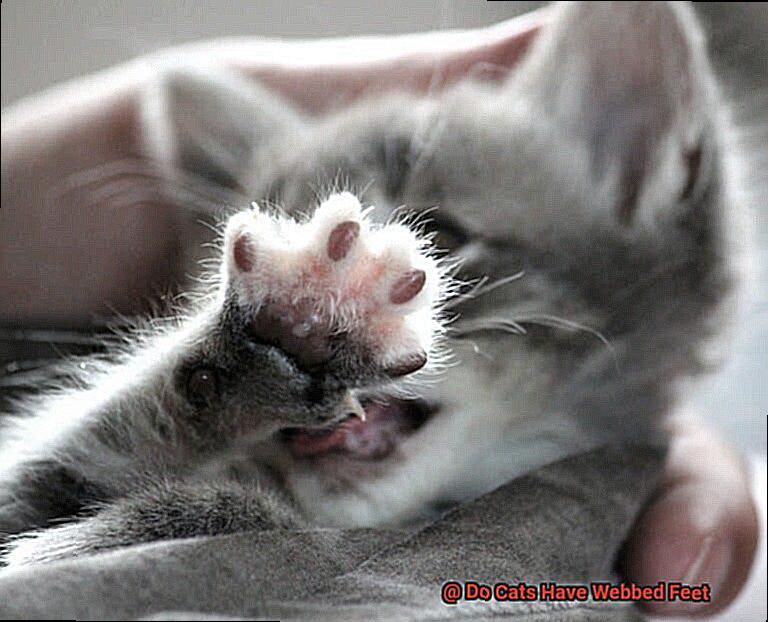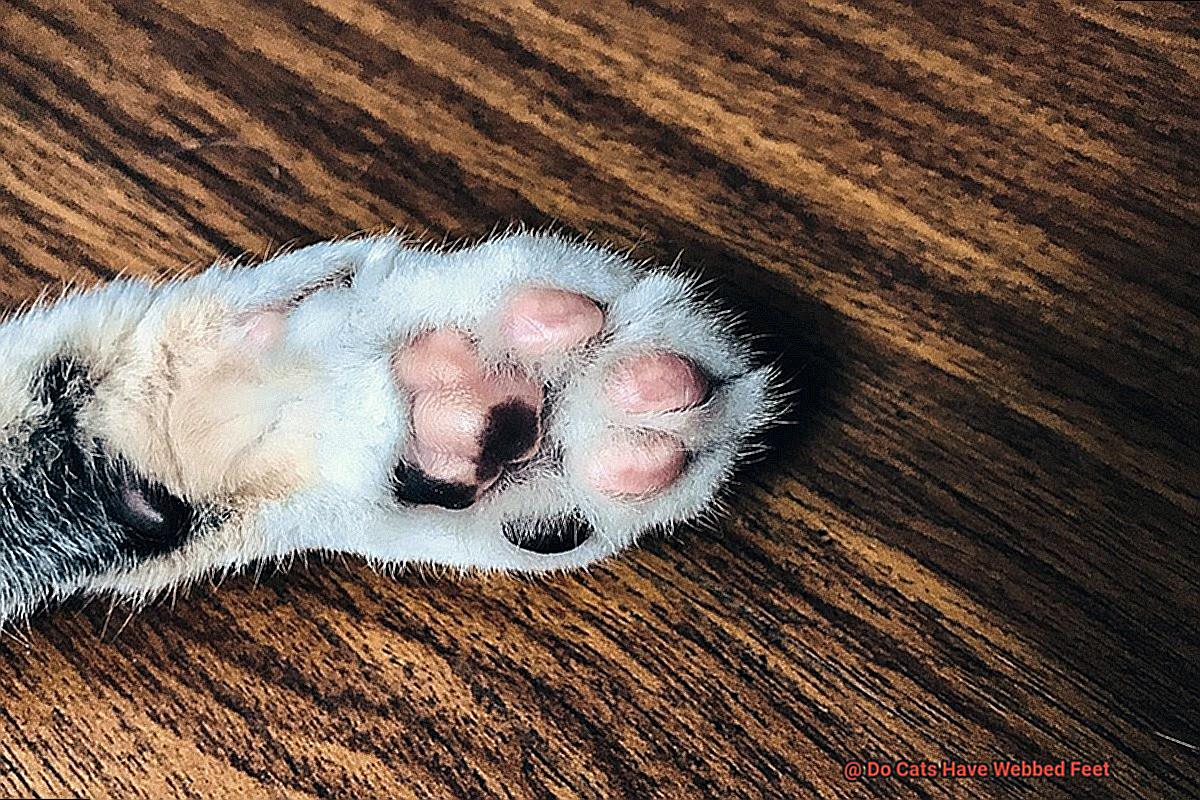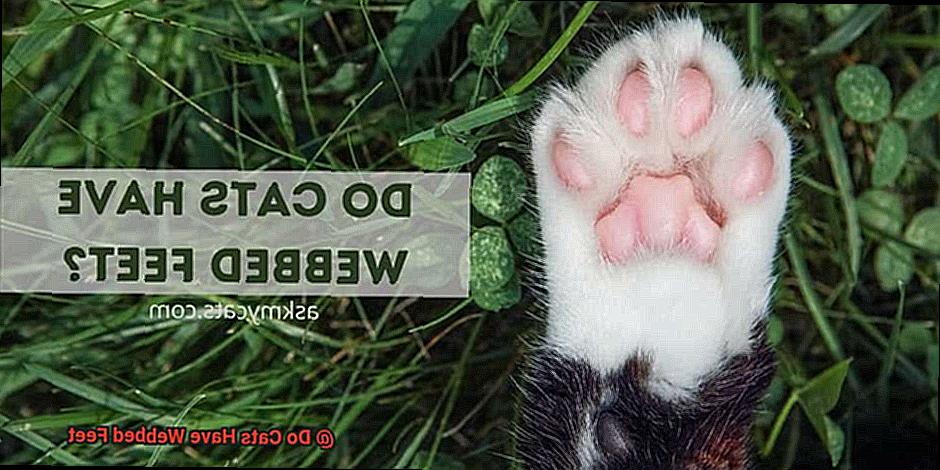Do cats have webbed feet? It’s a common question among pet owners. After all, cats are known to be excellent swimmers.
The answer is both yes and no. While some cats have slight webbing between their toes, it’s not the same as that of aquatic animals like ducks or geese. The webbing usually isn’t noticeable unless the cat is wet. Its purpose is to help the cat move more smoothly through water.
When swimming, cats with webbed feet often paddle with a circular motion instead of an up-and-down stroke like other animals do. This helps them move forward more efficiently and comfortably without expending too much energy. Plus, the extra surface area provided by the webbing helps cats stay afloat for longer periods of time while swimming.
Surprisingly, not all cats have webbed feet – yet they can still swim just as well. This suggests that there are other factors that contribute to a cat’s ability to swim, such as body size and muscle strength.
No matter what type of feet your cat has, it’s clear that they’re natural swimmers who can benefit from some degree of weeping between their toes. So if you’re curious about whether your feline friend has any extra help in the water, take a look at their paws next time they take a dip.

Types of Cats with Webbed Feet
Cats are known for their grace and beauty, but did you know that some cats have webbed feet? That’s right – some breeds of cats have webbing between their toes, just like ducks and otters. This unique adaptation allows them to swim and hunt with ease, making them extraordinary swimmers and hunters.
The Turkish Van is one of the most well-known breeds of cat that has webbed feet. Their ancestors had to adapt to living near Lake Van in Eastern Turkey, which is why they love water and swimming so much. Their webbing helps them paddle through the water effortlessly, allowing them to hunt fish and other aquatic prey with great accuracy.
Maine Coon cats are another popular breed with webbed feet. They have large, powerful paws featuring tufted toes and webbing between them, which helps them traverse through water easily.
The Savannah cat is a mix of a serval and domestic cat with a distinct appearance and webbed paws that allow it to run swiftly through water or on land with incredible agility.
American Bobtail cats also have webbed feet despite their short tails. These wildcats can survive in harsh wilderness by using their feet to search for fish with great speed and accuracy.
And although not as well-known for this trait, other cat breeds such as the Siamese Bengal and Birman also possess a certain degree of webbing in their paws.
Benefits of Webbed Feet for Cats
Cats are renowned for their agility and grace, but some breeds possess a special trait that allows them to move with ease through water. Cats with webbed feet have an edge over those without, helping them hunt and traverse both land and water with effortless precision.
The toes of cats such as the Turkish Van, Maine Coon, Norwegian Forest Cat, and Savannah Cat are all connected by webbing that aids them in swimming.
Additionally, it helps them walk on wet surfaces without slipping, giving them access to more hunting grounds. Webbed feet also make cats more agile and flexible in their movements on both land and water.
Although some cats may have webbed feet, not all cats possess this trait. Furthermore, just because a cat has webbed feet does not necessarily mean they will have an affinity for water. Each cat is unique with its own individual preferences and personalities.
When introducing any new activities or foods into your cat’s life, such as duck feet, it’s important to think about these things carefully. Although duck feet are high in protein and nutrient-rich, they can be difficult to digest and may pose a choking risk for cats.

If you’re considering feeding your cat duck feet, always consult with a veterinarian before introducing it into your diet.
Dangers of Webbed Feet for Cats
Cats with webbed feet are a surprising but real phenomenon. Breeds such as the Turkish Van, American Polydactyl, and Maine Coon all boast this unique trait. While webbed feet can be useful for cats in swimming or hunting, they can also pose some dangers.

Matting and trapping of debris between the toes is a significant risk associated with webbed feet. If left unchecked, this can lead to infection and discomfort for the cat. Regular grooming is key in preventing this issue.
In addition, cats with webbed feet may have difficulty walking on very smooth or slippery surfaces, increasing their risk of slipping and falling – particularly for older or less agile cats.
Finally, cats with webbed feet are more prone to getting wet due to their design aiding in swimming.
Most cats do not enjoy being wet and may become distressed if they are constantly getting soaked due to their webbed feet. Ensuring access to dry areas is important in keeping these cats comfortable.
Do All Cats Have Webbed Feet?
The answer is a resounding no. While some breeds of cats do possess webbed feet, it is not a trait that is universal to all cats. In fact, only a few select breeds have webbed feet, and those that do have them for a specific reason.

The Turkish Van, Maine Coon, Savannah cat, American Bobtail, and Norwegian Forest cat are all breeds known for having webbed feet. This extra skin between their toes helps them swim more efficiently and navigate through water. They can also be excellent hunters of fish and other aquatic prey.
However, even among these breeds not all individuals may have webbed feet. The trait is not always hereditary, so just because a cat is one of these breeds does not mean it will have webbed feet.
On the other hand, most domestic shorthair and longhair cats do not have webbed feet at all and this lack of webbing has no effect on their ability to climb or run – which is their primary mode of movement.
Can Cats Eat Duck Feet?
Cats love a tasty snack, and duck feet can be the perfect treat for your furry friend. Not only are they delicious, but they are also packed with essential nutrients that can help keep your cat healthy.
Duck feet are a great source of glucosamine, which is especially beneficial for joint health and mobility in cats as they get older. They’re also high in protein and natural collagen, promoting healthy skin, fur, and nails. However, it’s important to remember that duck feet should be enjoyed in moderation – too much of a good thing can be dangerous for cats.
If you want to offer your cat some duck feet as a special treat while still providing them with essential nutrients, start by giving them small amounts and gradually increase the serving size over time.
It’s also important to make sure the duck feet are cooked through before giving them to your cat – raw or undercooked duck feet can lead to bacterial infections like Salmonella which can be deadly for both cats and humans.
So if you want to give your cat a delicious snack that’s still good for them, try adding some cooked duck feet to their diet.
Nutritional Benefits of Feeding Duck Feet to Your Cat
Duck feet may be just the thing. Packed with essential nutrients such as glucosamine for joint health, protein for healthy skin, and collagen for promoting healthy hair and nails, duck feet can provide numerous nutritional benefits.
Glucosamine and chondroitin, both found in duck feet, can help reduce inflammation and stiffness in cats’ joints, especially in older cats with joint pains. Collagen found in duck feet can also aid in the production of keratin, the protein that strengthens hair and nails.
Additionally, duck feet contain glycine, an amino acid that helps break down food in the digestive tract so that cats can absorb nutrients more effectively.
Although feeding duck feet to your cat can be highly beneficial nutritionally, not all cats may enjoy them. Introduce them slowly and monitor their response to make sure they are adjusting well.
Additionally, ensure that the duck feet are properly cooked before giving them to your cat to avoid any health issues.
uJF2t42KzSQ” >
Safety Considerations When Feeding Duck Feet to Your Cat
There are some safety considerations to bear in mind before introducing them into your cat’s diet.
First and foremost, make sure the duck feet have been properly cleaned and cooked before feeding them to your cat. Raw duck feet can contain harmful bacteria that can make your cat sick, so it’s essential to ensure they are safe to eat.
When feeding duck feet to your cat, it’s also important to monitor portion size. Though they can be a healthy addition to their diet, too many can upset their stomach or cause a digestive blockage.
It’s also wise to supervise your cat while they eat duck feet. Small bones in the feet can pose a choking hazard, so it’s recommended to keep an eye on them while they eat and remove any leftover bones once they’re finished.
Finally, it’s always a good idea to consult with your veterinarian before feeding your cat any new type of food, including duck feet. Your vet can advise you on proper portion sizes and any potential health concerns based on your cat’s individual needs.
Conclusion
In conclusion, cats with webbed feet have certain advantages that enable them to more easily navigate both water and marshy environments. Breeds such as the Turkish Van, Maine Coon, Savannah Cat, American Bobtail, and Norwegian Forest Cat are all known for having swollen toes.
This helps them swim better and identify aquatic prey with greater accuracy.
However, not all cats have webbed feet – domestic shorthair and longhair cats lack this characteristic.
When it comes to duck feet treats for cats, they can be a tasty snack that also contains essential amino acids like glucosamine for joint health and collagen for healthy skin and hair.
But remember: too much of a good thing can be fatal for cats. So only give them duck feet in moderation – and make sure they’re cooked through before giving them to your cat to prevent any bacterial infections.







